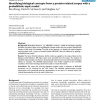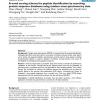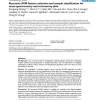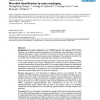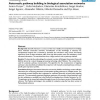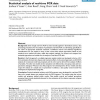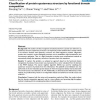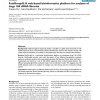BMCBI
2006
13 years 11 months ago
2006
Background: Biomedical literature, e.g., MEDLINE, contains a wealth of knowledge regarding functions of proteins. Major recurring biological concepts within such text corpora repr...
BMCBI
2006
13 years 11 months ago
2006
Background: Tandem mass spectrometry (MS/MS) is a powerful tool for protein identification. Although great efforts have been made in scoring the correlation between tandem mass sp...
BMCBI
2006
13 years 11 months ago
2006
BMCBI
2006
13 years 11 months ago
2006
Background: Prostate cancer is one of the leading causes of cancer illness and death among men in the United States and world wide. There is an urgent need to discover good biomar...
BMCBI
2006
13 years 11 months ago
2006
Background: The public availability of over 180,000 bacterial 16S ribosomal RNA (rRNA) sequences has facilitated microbial identification and classification using hybridization an...
BMCBI
2006
13 years 11 months ago
2006
Background: Scientific literature is a source of the most reliable and comprehensive knowledge about molecular interaction networks. Formalization of this knowledge is necessary f...
BMCBI
2006
13 years 11 months ago
2006
Background: The relationship between disease susceptibility and genetic variation is complex, and many different types of data are relevant. We describe a web resource and databas...
BMCBI
2006
13 years 11 months ago
2006
Background: Even though real-time PCR has been broadly applied in biomedical sciences, data processing procedures for the analysis of quantitative real-time PCR are still lacking;...
BMCBI
2006
13 years 11 months ago
2006
Background: The number and the arrangement of subunits that form a protein are referred to as quaternary structure. Quaternary structure is an important protein attribute that is ...
BMCBI
2006
13 years 11 months ago
2006
Background: High-throughput sequencing makes it possible to rapidly obtain thousands of 16S rDNA sequences from environmental samples. Bioinformatic tools for the analyses of larg...
